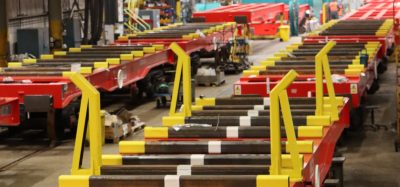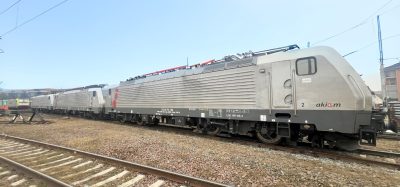Developing stronger rail transit from China to Europe and back
Posted: 4 June 2015 | | No comments yet
International experts believe successfully exporting goods and services to be essential to the national competitiveness growth in the foreign markets. Today, many nations employing such strategies come as examples of quality growth and economic development. Russia has an immense resource and production potential and is a major participant in the exchange process of cargo and commodities. Vladimir Yakunin, President of Russian Railways, explains that the export of transportation services may become a key national product of Russia.


For two decades, in the structure of Russian exports, priority was given to power resources like coal, oil, natural gas and metals. Yet, fluctuations in global economy plus the aggravation of political and military environment come as regular proof of the risky nature of this process pressing for switching export flows over to other industries. Many experts insist that the most probable prospects for Russian exports lie in the sector of transportation services. Due to its geographical position, Russia has a top advantage in the sphere. Being the land-bridge between Europe and Asia, the Russian Federation has every opportunity to develop freight traffic to anywhere on the continent.
International railway transit is one of the most important national economy export components. In Russia, the national carrier, JSC Russian Railways, offers the supply of this natural geostrategic potential.
Russian Railways keeps developing
Responding to global economy challenges and ever-growing Europe-Asia goods traffic, Russian Railways keeps developing international transport corridors for the 1520mm gauge unified railway area. In the last few years, Russia, Kazakhstan and Belarus have become much more attractive transit territory for foreign shippers. Developing transit technologies and introducing unified international railway cargo regulations bring more traffic of transit goods to the Customs Union railroad networks.
The ever-growing Asian economies, with China leading the way, are a strong growth driver for the development of the Eurasia railway transit. The reason for the establishment of new industrial hubs in central and southern regions of the country is PRC’s interest in developing stable markets and reliable supply chains. Keeping high demand for consumer industry products and home appliances, Europe remains the most important export market for PRC. According to the experts, and given the Chinese economy growth rates, the freight transportation market potential could exceed 1 million TEUs by 2020. This is more than a tenfold increase in the current market figures.
The Customs Union countries – Russia, Kazakhstan and Belarus – responded to the market growth by establishing the United Transport & Logistics Company (UTLC) in late-2014. The UTLC is aimed at developing a stronger container cargo transit and efficient use of the transit potential of Eurasian territories. UTLC consolidates the material and technological assets of Russian Railways and Kazakhstan and Belarus national carriers – Kazakhstan Temir Zholy and Belarusian Railways. The company will arrange freight traffic on China–EU, China–Central Asia destinations as well as in the domestic market. The UTLC plans to achieve a turnover of 4.2 million TEUs by 2020.
Today, JSC Russian Railways Logistics, a subsidiary of Russian Railways, plays an important part in the design and development of international transit corridors. The company organises container rail transport on two main corridors: the Trans-Siberian and Trans-Kazakhstan mainlines. Over four years in operation, Russian Railways Logistics has established stable cargo flows from China’s central and southern regions to Central Europe. In 2014, the company sent approximately 400 trains on routes including: Chongqing–Duisburg; Zhengzhou–Hamburg; Busan–Brest; and Suzhou–Warsaw.
Eurasian railway transit has several significant advantages
Compared to air and sea freight services, Eurasian railway transit has several significant advantages. The most important one is the best balance between speed and cost of the delivery. Although air freight from China to Europe is the fastest (about two days), the shipping expenses exceed several times the shipment costs of rail freight. As for maritime carriers, they offer the best prices but they have no competitive ability in the delivery time which may reach up to 40 days, they also provide no safety guarantees for goods transported. Seeing that, Eurasian rail routes seem to be the best choice. For example, the Suzhou–Warsaw train established by Russian Railways Logistics in 2013 covers the distance of 11,000km in 13-14 days. An average speed of the trains using Russian railway networks exceeds 1,000km per day.
Russian Railways employees do their best to accelerate traffic on the network. Russian Railways has made substantial investments into the railway infrastructure upgrade with the priority given to the traffic capacity increase resulting from the elimination of bottlenecks. The corporation’s logistics subsidiaries keep developing a distinct interaction system involving other nations’ railway carriers, borders and customs control institutions in order to accelerate train inspections and border crossings.
Moreover, Russian Railways Logistics has managed to lower seasonal fluctuations in train departure. The harsh winter in Russia and Kazakhstan has always been an obstacle for cargo flow continuity: senders of high-tech goods, especially electronic ware manufacturers, were afraid for the goods’ safety during transit. Russian Railways Logistics has solved the issue organising the so-called ‘cold-proof’ trains equipped with refrigerator containers to retain the proper storage temperatures. In the winter of 2013/2014, the company sent approximately 100 cold-proof containers on the Zhengzhou–Hamburg route.
Experts believe that the main factor hindering rail transit development is not high-level competition with maritime carriers or infrastructural limitations; it’s the imbalance in cargo flow. Today, the goods transit from China is much higher than the volume of cargo shipped in the opposite direction. Logistic solutions allowing to create China–Europe–China ‘loop’ routes are needed to lower transit transportation expenses. However, the Russian Railways everyday practice demonstrates that lowering the traffic costs to the prime cost level is not always a solution. Current forecasts indicate that even under this condition, the amount of direct transit from Europe to China by 2020 will not exceed 60% of the total direct transit from China to Europe.
The situation can be solved using more complex logistic solutions comprising chains from Europe to the European part of Russia and involving Russian domestic transportation over the Urals and to the Far East, from Russia to Kazakhstan or to China. Thus we could possibly cut the transit expenses from China to Europe and offer customers the services that would allow the switch to railway transit from maritime transportation.
The largest players can contribute to the Eurasian space transit potential development through cooperation. These are the objectives pursued by UTLC, which unites logistics, container and rail operators’ efforts to develop stronger rail transit from China to Europe and back.
Biography
Between 1985 and 1991, Vladimir Yakunin was in the service of the Soviet diplomatic mission to the United Nations – first as the Second Secretary and then as the Mission’s First Secretary. He then became the Chairman of the Board of CJSC International Centre for Business Cooperation, Director of the North-Western District Inspection of the Main Control Directorate of the President of the Russian Federation. In October 2000, Vladimir became Deputy Minister of Transport of the Russian Federation. Then, in February 2002, he was appointed the First Deputy of the Russian Minister of Railways Lines, and in October 2003 he became the First Vice-President of Russian Railways. In June 2005 Vladimir was appointed President of Russian Railways and has been Chairman of the UIC since 2012.







